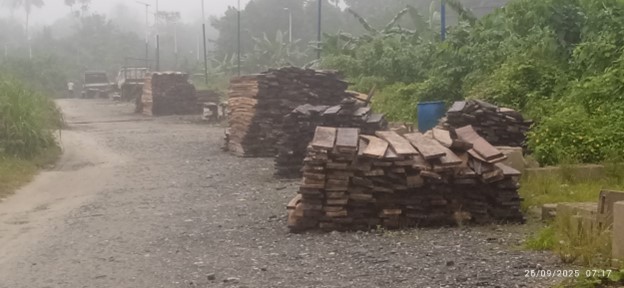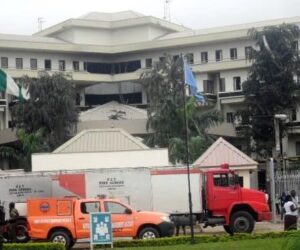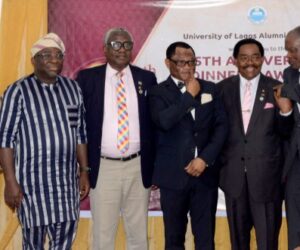Livelihood pressures, intensified by climate change and ineffective government policies, have driven communities such as Okolomade in Abua/Odual Local Government Area of Rivers State to abandon conservation rules and engage in widespread deforestation.
For 22-year-old Enaanasebhaami Mark, cutting and sawing trees is now the only viable means to maintain a livelihood. He once dreamed of studying welding and fabrication at the university, but poverty ended those hopes.
“I have been doing this work for one year and three months now,” he said. “My parents are poor farmers. I’ve written WAEC and passed, but there’s no money to continue school. This is the only work I have for now.”
Mr Mark and his friend, 23-year-old Bright Joseph, from the Okolomade community, are among dozens of young men now living off the forest. Mr Joseph, who lost his father early, is learning the ‘trade’ under Mr Mark. “I see this work as the only source of income in this part of the country,” he said. “I’ve written and passed my WAEC for over four years now. This is how we make income here.”
Odual community, a predominantly farming and fishing community in Rivers State near the border with Bayelsa, has faced years of neglect and recurrent flooding that destroys crops and disrupts livelihoods. With few employment opportunities and limited government support, many young people are now turning to tree felling and logging as a means of survival, despite earlier community-led efforts to protect the forests.
That shift, from conservation to exploitation, is devastating the community’s natural capital. Vast areas once rich in diverse flora and fauna are now stripped bare, threatening species found nowhere else. When a tree falls, smaller plants are destroyed along with it, worsening the forest depletion.

Some of these trees are medicinal, used for the treatment of malaria, typhoid, catarrh, and cough, while others produce edible fruits. Locals say many trees being cut are still immature.
Community rules
The Okolomade community has locally developed rules that guide forest use, including the size of wood that can be harvested.
According to local rules, a tree is considered mature enough to be cut when an adult can wrap their arms around its trunk and their hands cannot meet, or only reach halfway. Mature trees can yield three to four timber logs, with planks typically measuring eight by twelve inches or larger, and cubic sizes of twelve by sixteen inches or sixteen by thirty-two inches or more. This contrasts sharply with the much smaller sizes now being produced from immature trees.
Originally, trees were felled only for timber. But in recent years, commercial sawing has become common, leading to the abandonment of local regulations. As a result, the planks now being produced are much smaller, typically measuring two by eight inches in thickness and width, and cut to lengths of ten, twelve, thirteen, or fourteen feet, a reflection of the absence of mature trees.

The community, however, prohibits the cutting of ogbono (Irvingia gabonensis) and African oil bean, popularly known as “Ugba” in Nigeria, because of their economic value.
Chainsaws and survival
When Dataphyte visited the Okolomade community recently, the forest floor was strewn with felled and sawn trees cut down by young people. Many of these trees once provided shelter for various animal species, but with ongoing deforestation, those animals are now disappearing.
The sound of saws and machinery echoed from morning till evening in Odual and Okolomade communities, where stacks of wooden planks lined the forest edges and village outskirts, ready to be transported to nearby cities.
The tree species affected include the cotton tree, mahogany, iroko, abura, white afara, black afara, and “a thousand legs” (a name given by locals due to its many branches), as well as African breadfruit and several other species whose names are unknown to the locals in English. Additionally, it was observed that this trade represents a cycle for young men, encompassing the processes of felling, sawing, carrying, and loading the wood into waiting vans.
Local leaders losing grip
Despite widespread disregard for conservation rules, community leaders say they feel powerless, insisting that logging and tree felling remain the only source of livelihood for many young people.
“The community is helpless because stopping young men from cutting down trees may lead to crime and criminality,” Osebhenaan Micah, a former youth leader in Okolomade community, said. “In this community, there is no other means of livelihood. The only means of living here is timber,” Mr Micah said.
For Mr Micah, the situation is fuelled by worsening flooding incidents and the limited availability of alternative jobs for young graduates.
“Most of us are graduates, but no employment,” Mr Micah said. “In politics, nobody cares about us. This community does not have up to five persons who the local government employs, maybe one or two persons.”
ALSO READ:
COP30: Amid rising heat, sustainable cooling can slash emissions and save trillions of dollars – Report
‘’If the government wants to stop the unsustainable felling of trees,’’ Mr Micah said, “let them look into our situation. We have so many youths, let them bring programmes that will empower us in the area of vocational training and support people to do businesses.”
The Chairman of the Community Development Committee (CDC), Patrick David, said that the Community leadership’s efforts to preserve the forest trees have not been successful due to the livelihood pressures faced by young people. “The boys are hustling for money,” he said.
Mr David explained that flooding has indirectly increased deforestation in the community. “Flood cannot destroy trees, but flood can destroy farming, which increases pressure to maintain livelihood by cutting trees,’’ the CDC chairman stated.
Nigeria’s forest depletion crisis
Deforestation is a global problem, driving dangerous warming and biodiversity loss. In Nigeria, a Global Forest Watch report revealed that 96% of the tree cover loss from 2001 to 2024 is attributed to humans, with the remaining 4% attributed to other causes, like natural disturbances and fires.
Rivers State has faced a substantial loss of forest cover. According to Global Forest Watch, in 2020, Rivers State had 485,000 hectares of natural forest, accounting for 57% of its total land area. However, by 2024, the state lost 2,020 hectares of natural forest, resulting in emissions of approximately 1.40 million tonnes of CO₂.

A senior official in the Ministry of Agriculture in Rivers State, who requested anonymity due to a lack of authorisation to discuss this issue, blamed the government for the failure to manage forests sustainably.
The official, a director, pointed out that although there are laws, policies, and guidelines at the national level, Rivers State has its own forest law, which remains unimplemented.
The director mentioned that there are currently no forest guards due to a staff shortage in the ministry. “In the past, we had forest guards who monitored our forests,” the director said.
“Reserved forests were established to preserve both flora and fauna and to regulate how people utilised these areas. Because the government has neglected the forests, communities have taken control of them.”
The director clarified that, according to the law, logs should not be sawn directly at the cutting site. Instead, they should be transported to approved mills.
“There is a specified girth for timbers, but what is currently being sold in the markets is undersized,” the director stated.
This story was produced as part of Dataphyte Foundation’s Biodiversity Media Initiative project, with support from Internews’ Earth Journalism Network. We have permission to publish.












